Back To Blogs / Blogs / Mar 2024
Land of One Million Elephants
Luang Prabang, nestled in the lush, mountainous landscape of northern Laos, is a UNESCO World Heritage Site and a jewel of Southeast Asia. This charming town, situated at the confluence of the Mekong River and Nam Khan rivers, is renowned for its well-preserved architecture, rich cultural heritage, and serene atmosphere.
Luang Prabang served as the capital of the Kingdom of Laos for centuries. Its historical importance is reflected in the many temples and palaces that adorn the city. The town is home to numerous ornate temples and monasteries, each a showcase of Laotian religious and artistic traditions.
Luang Prabang's recognition as a UNESCO World Heritage Site has spurred efforts to preserve its unique cultural and architectural heritage. Strict building regulations ensure that new constructions adhere to traditional styles, preserving the town's charm.
You can visit Luang Prabang during Pandaw’s 10 night Laos Mekong expedition which takes intrepid travellers along some of the most remote parts of the Mekong River. Sailing between Vientiane, the Laotian capital and Chiang Khong on the Thailand side of the border the 10 night adventure stops for 3 nights in Luang Prabang, providing plenty of time to discover the history and charm of the former capital.
Land of One Million Elephants
Luang Prabang's nickname, "One Million Elephants," traces its roots to the ancient Lan Xang Kingdom, which translates to "Land of a Million Elephants." Established in the 14th century by King Fa Ngum, this powerful kingdom played a pivotal role in shaping the region's history. The symbol of the elephant has endured, reflecting strength, resilience, and prosperity.
Originally known as Muang Sua, Luang Prabang became the first capital of Laos in the 14th century. The city got its current name when Cambodia gave a gold Buddha image called the Phra Bang as a gift. This image became the city's symbol and is displayed in a museum. Over the years, the city faced various rulers and changes until it became the capital of the independent Luang Prabang Kingdom in 1707.
When France took over Laos, Luang Prabang was recognized as the royal residence. After Laos gained independence, Luang Prabang's king, Sisavang Vong, became the head of state. During the Franco-Thai War, Thailand occupied part of the province, but after the Washington Accord of 1946, the annexed territories were returned to Laos.
Today, Luang Prabang stands as a historical and cultural gem, showcasing the resilience and enduring spirit of the city through centuries of change.
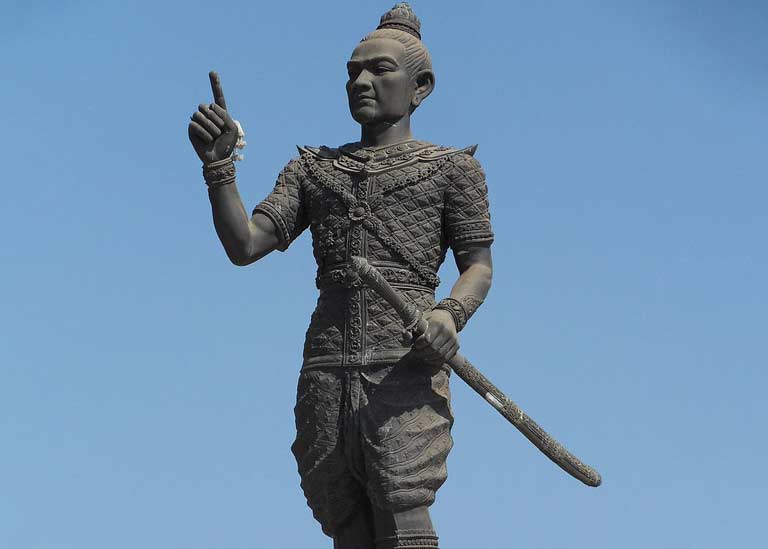
King Fa Ngum
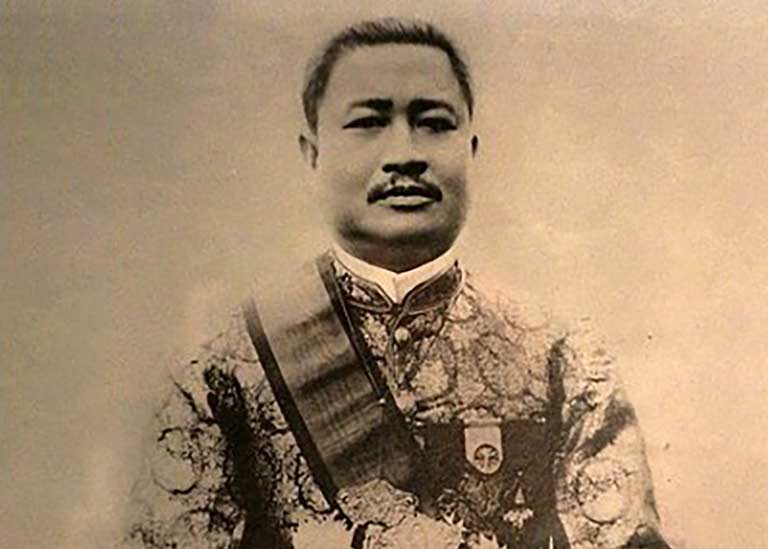
King, Sisavang Vong
Royal Legacy
Luang Prabang carries a rich royal legacy that spans several centuries, marking its significance as the historical capital of the Kingdom of Laos. The town has been under the rule of various dynasties, each leaving an indelible mark on its culture and heritage.
The Khun Lo Dynasty
Luang Prabang's history can be traced back to the Khun Lo Dynasty, which is said to have established the town in the 7th century. Little is known about this early period, but it laid the groundwork for Luang Prabang's future as a political and cultural center.
According to local folklore, the town was established by Khun Borom, a mythical figure who is said to have descended from heaven. Khun Borom is credited with founding the Khun Lo Dynasty and establishing Luang Prabang as its capital.
Khun Borom chose the picturesque confluence of the Mekong and Nam Khan rivers as the site for his earthly abode. Here, he founded the town that would eventually become Luang Prabang. The settlement was strategically positioned for trade and cultural exchange, surrounded by the natural beauty of mountains and rivers.
The Khmer Empire Influence
The Khmer Empire's influence on Luang Prabang during the 9th to 13th centuries was a transformative period, shaping the town's architecture, art, and religious practices.
The Khmer Empire was predominantly Hindu, and this influence extended to Luang Prabang's religious practices during this period. Temples erected in Luang Prabang exhibited a syncretic blend of Hindu and local animist beliefs, with lingam and yoni symbols often incorporated into the religious iconography.
Elements such as prang-style towers, intricate bas-reliefs, and ornate carvings became prominent features in the construction of religious buildings in Luang Prabang. Wat Xieng Thong, one of the most revered temples in the town, showcases Khmer influence in its design and ornamentation.
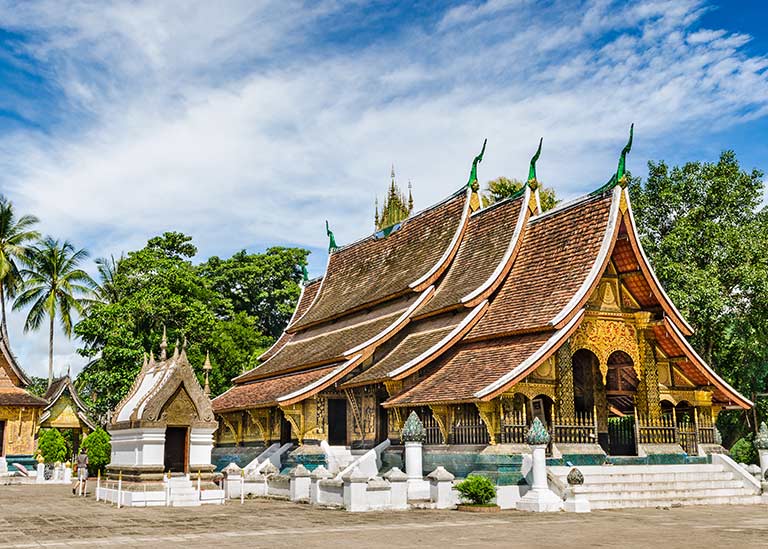
Wat Xieng Thong
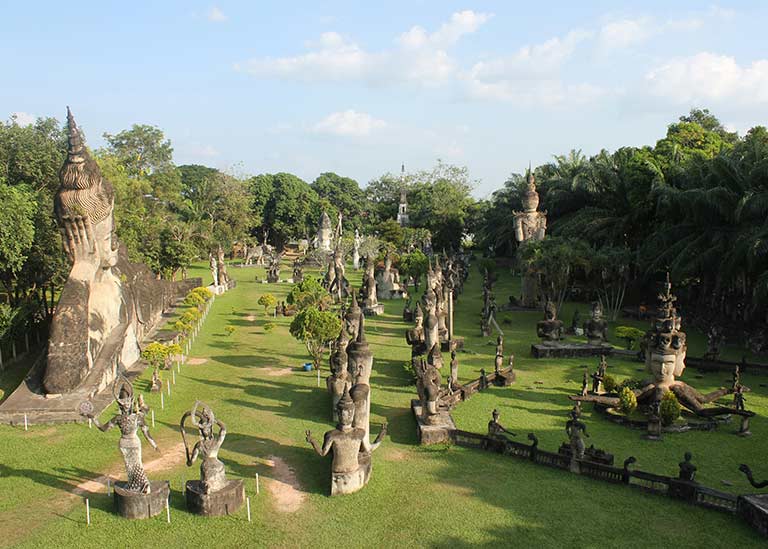
Wat Xieng Thong
The Lan Xang Kingdom
The Lan Xang Kingdom, translated as the "Kingdom of a Million Elephants," stands as one of the most significant chapters in the history of Laos. Its influence on Luang Prabang, the former capital, is profound. Founded in the 14th century, the kingdom played a pivotal role in shaping the political, cultural, and religious landscape of the region.
Lan Xang was established in 1354 by King Fa Ngum, a charismatic and ambitious leader. Fa Ngum, who had been exiled from his homeland in present-day Vietnam, gathered support from local rulers and formed a powerful coalition. With military prowess and strategic alliances, he unified the diverse principalities in the region to create the Kingdom of Lan Xang.
Luang Prabang, strategically located at the confluence of the Mekong and Nam Khan rivers, was chosen as the capital of Lan Xang. The town's natural surroundings and favorable geography played a crucial role in its selection as the political and cultural center of the kingdom.
Under the reign of Fa Ngum and subsequent rulers, Lan Xang expanded its territory, encompassing parts of present-day Laos, Thailand, and Vietnam. The kingdom's central location facilitated trade along the Mekong River and contributed to its prosperity.
Lan Xang played a crucial role in the spread of Theravada Buddhism in the region. King Fa Ngum embraced Buddhism and established it as the state religion. Temples and monasteries flourished, with Wat Xieng Thong in Luang Prabang becoming a prominent center of Buddhist learning and worship.
Despite its initial success, Lan Xang faced internal strife and external pressures. Successive rulers struggled to maintain unity among the diverse ethnic groups within the kingdom.
In the 18th century, Lan Xang fragmented into three successor states: Luang Prabang, Vientiane, and Champasak. Each state maintained its cultural identity and governance, but the era of a unified Lan Xang came to an end.
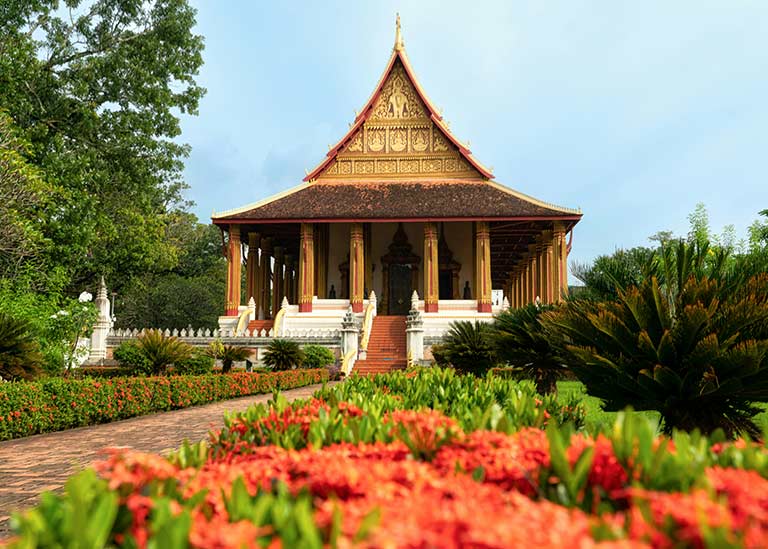
Vientiane
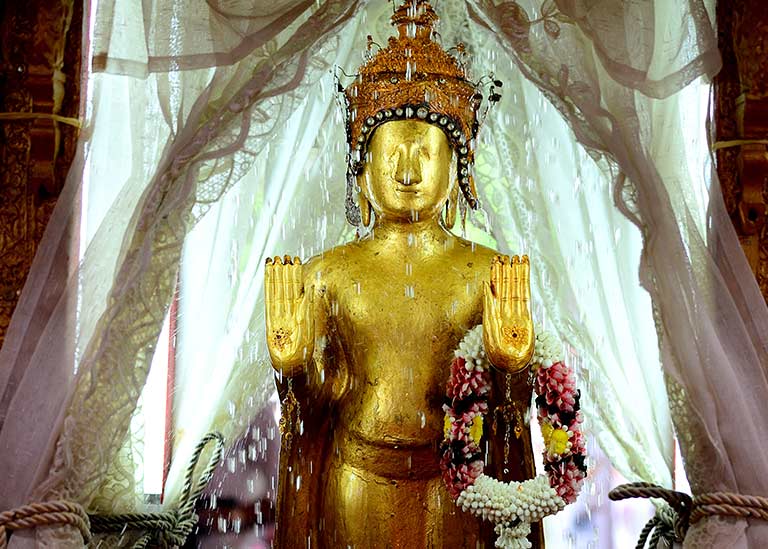
Vientiane
The Phra Bang Dynasty
Named after the sacred Buddha image known as the Phra Bang, this dynasty played a significant role in shaping the cultural, religious, and political landscape of Luang Prabang for several centuries.
The Phra Bang Buddha image, believed to be cast in Sri Lanka, arrived in Luang Prabang in the 16th century. King Visoun, the ruler of Luang Prabang at that time, brought the revered statue to the town, establishing it as a symbol of divine legitimacy and authority. With the arrival of the Phra Bang image, King Visoun founded the Phra Bang Dynasty, which would rule Luang Prabang for several centuries. The dynasty's establishment solidified the connection between royalty, Buddhism, and the spiritual well-being of the kingdom.
The Phra Bang rulers were strong patrons of Theravada Buddhism, contributing to the spread and consolidation of this form of Buddhism in the region. Temples and monasteries flourished under their patronage, and Buddhist teachings became integral to the fabric of Luang Prabang society.
The construction of Wat Xieng Thong, one of the most revered temples in Luang Prabang, is attributed to the Phra Bang Dynasty. This masterpiece of Lao temple architecture stands as a testament to the dynasty's commitment to religious and cultural development.
The late 19th and early 20th centuries brought the challenges of French colonialism to Laos. While the Phra Bang Dynasty maintained some autonomy during this period, the influence of external forces and colonial policies impacted the traditional governance of Luang Prabang.
French Colonialism
French colonization of Laos, including Luang Prabang, occurred during the late 19th century. In 1887, the French established the territory of French Indochina, which included Laos, Vietnam and Cambodia. Luang Prabang, being part of Laos, came under French influence.
The Franco-Siamese War concluded with the signing of the Treaty of Hu? in 1893. As a result, Laos, including Luang Prabang, became a French protectorate within French Indochina. This marked the formal beginning of French colonization in the region. During World War II, Laos, including Luang Prabang, fell under Japanese occupation. The Japanese allowed the French colonial administration to continue with limited authority. After the war, Laos briefly declared its independence.
In 1946, the French returned to reassert control over Laos, leading to a period of conflict and negotiations with the Lao Issara government, which sought full independence.
The First Indochina War concluded with the signing of the Geneva Accords in 1954. Laos was granted full independence, and the French withdrew from the region. Luang Prabang became the capital of the newly independent Kingdom of Laos.
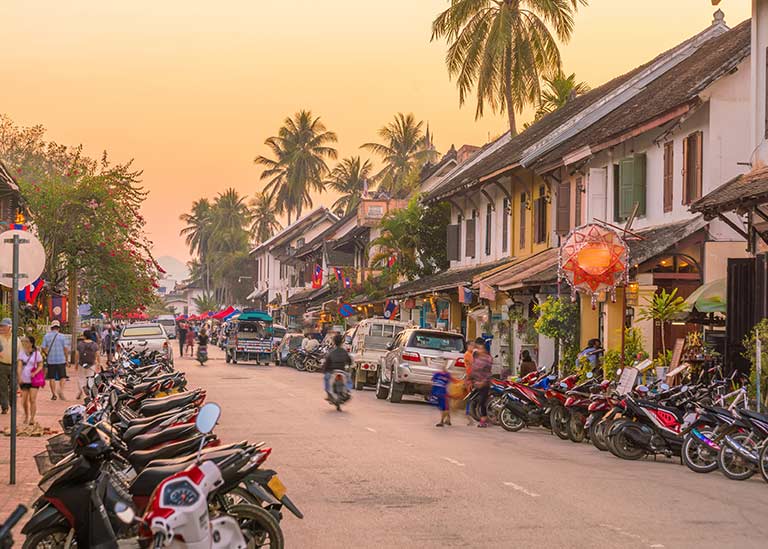
Luang Prabang
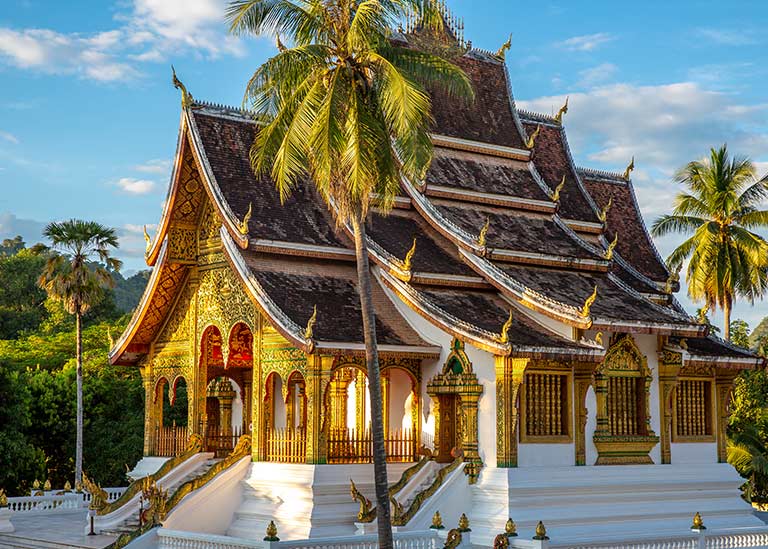
Royal Palace, now the National Museum
The Pathet Lao and the End of the Monarchy
The Pathet Lao emerged as a communist movement in the early 1950s, inspired by the ideology of Marxism-Leninism. It aimed to overthrow the existing political order, which included the Lao monarchy and the French colonial presence. The Pathet Lao was actively involved in the struggle against French colonial rule and sought to establish an independent, unified, and socialist Laos. They received support from the Democratic Republic of Vietnam and operated from remote areas, including parts of northern Laos.
The First Indochina War ended with the signing of the Geneva Accords in 1954. Laos was granted full independence, and a coalition government was established. However, internal tensions persisted, and the Pathet Lao continued to push for a more dominant role. Luang Prabang, being the royal capital, became a focal point of political struggles. The royal family, led by King Sisavang Vong, resisted the Pathet Lao's communist ideology and sought to maintain the traditional monarchy.
The ensuing Laotian Civil War (1960-1975) saw the Pathet Lao receiving support from North Vietnam and the Soviet Union, while the royalist forces, including the Laotian government, received support from the United States.
In 1975, following the fall of Saigon and the end of the Vietnam War, the Pathet Lao seized control of Vientiane, the capital of Laos. This marked the end of the Laotian monarchy.
On December 2, 1975, the Lao People's Democratic Republic was officially declared, and the monarchy was abolished. The Pathet Lao, now the ruling communist party, established a one-party state.
Today, remnants of Luang Prabang's royal legacy can be explored in the form of the Royal Palace, now the National Museum, which showcases artifacts and exhibits reflecting the town's historical significance. Despite the changes over the centuries, Luang Prabang continues to be a living testament to its royal past, inviting visitors to immerse themselves in the cultural richness of this enchanting town.